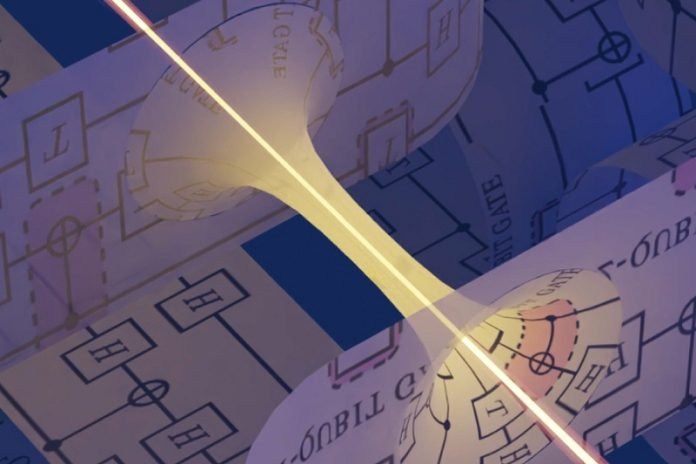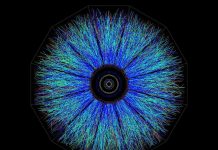
For the first time, scientists at MIT, Caltech, Harvard University, and elsewhere sent quantum information across a quantum system in what could be understood as traversing a wormhole.
Though this experiment didn’t create a disruption of physical space and time in the way we might understand the term “wormhole” from science fiction, calculations from the experiment showed that qubits traveled from one system of entangled particles to another in a model of gravity.
This experiment performed on the Sycamore quantum processor device at Google opens the doors to future experiments with quantum computers to probe ideas from string theory and gravitational physics.
“Simulating strongly-interacting quantum systems, such as those that arise in quantum gravity, is one of the most exciting applications of quantum computers,” says Daniel Harlow, the Jerrold R. Zacharias Career Development Associate Professor of Physics and a researcher at the MIT Laboratory for Nuclear Science (LNS) who works with David Kolchemeyer, one of the lead authors of the work.
“This is a promising initial step.”
In a new paper in Nature, a team of physicists, including MIT Center for Theoretical Physics (CTP) and LNS researchers Kolchmeyer and Alexander Zlokapa, presents results on a pair of quantum systems that behave analogously to a traversable wormhole.
A wormhole is a bridge between two remote spacetime regions. In the classical general theory of relativity, nothing is allowed to pass through the wormhole.
In 2019, Harvard University’s Daniel Jafferis and his collaborators suggested a wormhole could be traversable when created by entangled black holes. Kolchmeyer, a postdoc working with CTP and LNS researchers Harlow and Assistant Professor Netta Engelhardt, was advised by Jafferis for his PhD.
“These physicists discovered a quantum mechanism to make a wormhole traversable by introducing a direct interaction between the distant spacetime regions, using a simple quantum dynamical system of fermions,” says Kolchmeyer.
“In our work, we also used these entangled quantum systems to produce this kind of ‘wormhole teleportation’ using quantum computing and were able to confirm the results with classical computers.”
Spooky action at a distance
In this experiment, researchers sent a signal “through the wormhole” by teleporting a quantum state from one quantum system to another on the Sycamore 53-qubit quantum processor.
To do so, the research team needed to determine entangled quantum systems that behaved with the properties predicted by quantum gravity — but that were also small enough to run on today’s quantum computers.
“A central challenge for this work was to find a simple enough many-body quantum system that preserves gravitational properties,” says Zlokapa, a second-year graduate student in physics at MIT who began this research as an undergraduate in Spiropulu’s lab.
To achieve this, the team used techniques from machine learning, taking highly interacting quantum systems and gradually reducing their connectivity.
The output of this learning process produced many examples of systems with behavior consistent with quantum gravity, but each instance only required around 10 qubits — a perfect size for the Sycamore processor.
“The complex quantum circuits required would have made larger systems with hundreds of qubits impossible to run on quantum platforms available today, so it was important to find such small examples,” says Zlokapa.
Confirmed by classical computers
Once Zlokapa and the researchers identified these 10-qubit systems, the team inserted a qubit into one system, applied an energy shockwave across the processor, and then observed this same information on the other quantum system on the processor.
The team measured how much quantum information passed from one quantum system to the other depending on the type of shockwave applied, negative or positive.
“We showed that if the wormhole is propped open for long enough time by the negative energy shockwaves, a causal path is established between the two quantum systems. The qubit inserted into one system is indeed the same that appears on the other system,” says Spiropulu.
The team then verified these and other properties with classical computer calculations. “This is different from running a simulation on a classical computer,” Spiropulu says.
“Although one could simulate the system on a classical computer — and this was done as reported in this paper — no physical system is created in a conventional simulation, which is the manipulation of classical bits, zeros and ones. Here, we saw the information travel through the wormhole.”
This new work opens up the possibility of future quantum gravity experiments with larger quantum computers and more complicated entangled systems. This work doesn’t replace direct observations of quantum gravity, for example from detections of gravitational waves using the Laser Interferometer Gravitational wave Observatory (LIGO), adds Spiropulu.
Both Zlokapa and Kolchmeyer are keen on understanding how such experiments can help advance quantum gravity. “I’m very curious to see how much further we can probe quantum gravity on today’s quantum computers.We have some concrete ideas for follow-up work that I’m very excited about,” says Zlokapa.
Written by Julia C. Keller.



